Maritime
-
- The Rise of Primary and Secondary Maritime Schools Marine News, Jun 2014 #42
Education for the next generation, employment for life. A new source of talent emerges for maritime stakeholders everywhere.
Primary and secondary maritime schools are sprouting up across the country, inspiring K-12 students to learn about the exciting, yet sometimes obscured domestic waterfront. The goals of these maritime school programs are many and multifaceted, but at the core they motivate and engage students by bringing something new and exciting to the classroom while giving teachers an effective means for capturing the attention of their classes. And as new student audiences are being exposed — earlier, rather than later — to the maritime industry and potential career paths that could lie ahead, it’s not only students and educators who stand to reap the rewards of these programs.
The domestic maritime industry, spanning blue and brown water mariners, dock workers, operations, oil and gas and a dozen other sectors is starving for fresh, young talent to meet a shortage of qualified workers, especially in entry level and crew positions. What better way to work toward filling these gaps than to educate the nations’ youth on the importance of its culture-rich maritime heritage?The Beginnings of Maritime Education
Formal maritime training in the United States began to take shape with the opening of the U.S. Naval Academy and the first civil maritime school in New York City in the mid 1800s, answering the call for more advanced training to meet the demands of evolving ships and marine technology. Maritime education received another boost with a resurgence of marine activity following World War II. In 1946, the War Shipping Administration transferred former Liberty Ship SS John Brown to the New York City Board of Education to serve as part of the Metropolitan Vocational High School, providing high school students with deck, engine and stewards training until a declining interest in vocational education and shipping opportunities forced its closure in 1982.
The Marine Engineers Beneficial Association (MEBA), open from 1966-1986, offered a three-year program designed to train high school graduates to become licensed third assistant engineers in the Southern Hotel in Baltimore through formal classroom education and onboard trainee apprenticeships.
Still in operation today, the Seaman’s International Union (SIU) created the Paul Hall Center for Maritime Training in Piney Point, Md. in 1967 with a center that conducts professional and vocational training for unlicensed seaman. The school has put more than 21,000 high school graduates between the ages of 18-30 through an apprentice program consisting of classroom and shipboard training to qualify as entry level seamen in the deck, engine and stewards department.
Renewed Focus
A major turning point for maritime education occurred in 2001 when the Maritime Administration (MARAD) and U.S. Coast Guard (USCG), recognizing a shortage of mariners, hosted a conference at the U.S. Merchant Marine Academy called “Maritime Careers Creating an Action Plan for Recruiting and Retaining American Mariners.” Prominently among the topics covered at the conference was “Public Education and Awareness of the Maritime Industry,” which sparked a follow-up meeting on implementing action plans in 2002.
The movement gained momentum and focus in the years followed. Helping to lead the charge was Capt. Art Sulzer (USN Ret.). If not the founding father of modern maritime primary/secondary education in America, he is still by far its biggest champion. His involvement in maritime secondary education dates back to the early 2000’s when he was commissioned to share his maritime insight with a newly forming charter school in Philadelphia. Well known in maritime circles, Sulzer currently serves as a Presidential appointee on the St. Lawrence Seaway Board. Sulzer has done a lot of things, but his education push is one of his most high profile efforts. Sulzer, who holds an Ed.D. from the University of Pennsylvania with a focus on primary and secondary maritime education, testified to congress in on the subject in 2008.
Also in 2008, the Ship Operators Cooperative Program (SOCP) sponsored a two-day event titled “Maritime and Intermodal Education for Primary and Secondary Schools in America - On Board to a Future Career.” Gathering participants spanning the industry, from government agencies and existing maritime middle and high schools, to private companies and individuals, all came together with the shared goal of advancing maritime awareness in the United States and introducing K-12 students to what the maritime industry has to offer. In his keynote address, Rep. Elijah Cummings (D.-Md.), then Chairman of the Committee on Coast Guard and Maritime Education, highlighted the national problem of low graduation rates at city schools across the country (50 percent of city high school students do not graduate), offering maritime education as an opportunity to expose students to something interesting to focus on.
From the conference spawned the SOCP’s Maritime Education and Workforce Development Committee to continue initiatives addressed at the conference, and from there launched the Maritime for Primary and Secondary Education Coalition (MPSEC) to foster and promote maritime education in urban schools by working with a network of local, state and federal agencies, private employers, maritime associations, higher education institutions and other interested partners.
To date the MPSEC has led a number of widespread initiatives promoting maritime education, including the development of a national model curriculum for grades 5-12, a national maritime/transportation introductory course introducing 9th graders to related careers ashore and afloat, a 10th grade course on entry level maritime skills, an “Adopt a Maritime School” program and a project to expand e-learning in maritime schools, to name a few.
These initiatives are working, Sulzer said, but the proof is also in the numbers: “In 2001 there was one maritime high school and two marine high schools, and in 2008 there were maybe a dozen. Now in 2014, there are over 40 marine, maritime and transportation type high schools around the country.”
About the Schools
The existing maritime schools are mostly found near major U.S. ports along the Atlantic and Pacific Coasts, as well as on the Great Lakes, in cities such as Philadelphia, New York, Toledo , San Diego, Houston, Baltimore, Palm Beach and Seattle. The schools can be separated into two main categories: marine, which focuses on oceanology, biology and marine sciences; and maritime, which deals with subjects, training and skills required to work in the maritime sector, whether it be as a crew member at sea or shoreside such as in a marine, shipyard or port facility.
The schools teach general subjects (math, science, history, etc.) “marinated” with maritime themes, Sulzer said. Each school meets required state common core requirements, but with a maritime flavor. This is accomplished in a number of ways. Sulzer lists several program styles and types to categorize primary and secondary schools used to present marine and maritime materials to the students.
Many marine and maritime schools follow one or more of the program styles or types. Sulzer explained that grades K-8 usually follow a more integrated-type program, where 9-12 get more specific into industry related materials.
The New York Harbor School, for example, has all the same core academic programs as and standard public high school but on top of that has a four year scope and sequence of Career and Technical Education Coursework which gives students an introductory course in 9th grade before steering them toward choosing one of several college and industry approved Career and Technical Education Coursework routes: aquaculture, marine biology research, marine systems technology, ocean engineering, scientific diving and vessel operations.“That allows [students] to focus on something they can be good at, even if they haven’t been good in traditional academic subjects,” said the school’s cofounder Murray Fisher.
“We do a good job in helping kids find ways to be successful,” Fisher added, “Finding, multiple ways to be successful is important.” The New York Harbor School offers safe, engaging and fun opportunities that are often hard to find for inner city kids, Fisher explained.
The Maritime Academy Charter High School in Philadelphia (Pennsylvania’s only maritime-specific charter school), with Sulzer as one of its founding board members, started as a grade 5-8 school, but has since expanded to a 4-12 school with 820 students and ambitions to expand to K-12. “We teach the maritime industry. Of course our focus is on academics, but we intertwine the state’s common core standard curriculum with maritime themes,” said Ed Poznek, the school’s Principal and CEO.
“People come to our school because we offer strong academics . . . students and their families come to us because of who we are and the reputation that we carry,” Poznek said. Its reputation is well deserved. The Maritime Academy has a 98 percent graduation rate, nearly double the national average for urban schools. Poznek credits the maritime factor as a chief driving force behind the school’s success. “Our students really take pride in the fact that they are called cadets, especially our 4th, 5th and 6th grade students. It gives them a sense of pride unlike other schools,” Poznek explained. “The standards and expectations of a cadet are much higher, and we emphasize that our students do their best and give 100 percent.”
Another maritime school, the Maritime Academy of Toledo, initially embarked with the ambition to bring inner city kids and their families to the water through a focus on recreational boating, eventually evolving (with Sulzer’s help) to a maritime-centered program by the time it opened its doors in 2006. It too has benefited greatly from maritime themes, and has seen enrollment increase every year.
To achieve success, educators and administrators at maritime schools have found creative ways to integrate maritime themes. Students in Toledo are on the school’s boat every day of the week for courses in art, math, music, geography, etc. The school offers a diverse range of maritime courses, covering everything from welding and ecosystems, to fishing to culinary.
“Everything you can imagine that connects curriculum content to the water is what my teachers are doing,” said Renee Marazon, founder and Superintendent of The Maritime Academy of Toledo. For Cinco de Mayo, students in Toledo’s school used simulators to navigate waters in Mexico. “It’s so much fun to see these kids light up when they’re learning and exploring – and enjoying learning. The kids are learning to love to learn.”
Poznek said the Philadelphia school takes frequent maritime-themed fieldtrips, such as its most recent visit to Penn Terminal, where students were given the opportunity to learn about what the terminal does and how it serves the maritime industry. “It’s exciting for a group of students to stand in front of a ship and learn about the operations that occur.” The school has also taken its students aboard bulk carriers, tugboats and tall ships.
Maritime educators advocate that infusing maritime themes in primary and secondary schools helps to hold students attention while generating, enthusiasm, excitement, camaraderie and discipline. That positivity seems poised to transcend to the commercial sector.
The NextStep – Industry Cooperation
For many maritime schools, the next step is to connect students with potential employers, or as Sulzer describes it, “pass the baton.” Graduates from these programs have received an introduction to the maritime world and are well positioned to take up jobs within a sector that so desperately needs new workers. “The first thing is we get kids to graduate. The second is we help develop their academic standards,” Sulzer said. “The third thing, which is where we are now, is we need to take these young people and hand them off, whether it’s to an employer, a maritime academy, a union trade school or two-year maritime college. We need to hand them off to make sure they don’t fall through the cracks.”
Poznek said the Maritime Academy is very much tied into Philadelphia’s local maritime community, with connections to the Port of Philadelphia and most of the city’s maritime organizations. “As a result, Poznek said, “the maritime industry knows about our school; they know about our students.”
Next, the school plans to expand internship and externship possibilities “for students to actually go out into the business community and interact with the maritime businesses, and of course learn more about maritime opportunities,” Poznek said, adding that the school has recently hired a new guidance counselor to help students explore potential maritime careers.
According to Fisher, the New York Harbor School essentially prepares its 450 9th-12th grade students for positions in the marine and maritime field: “It’s introducing our kids to job markets that are very underrepresented by women and minorities while training them for an entry level job in that career.” After completing required internships within the local community, students have earned a technical credential and are prepared for entry level jobs upon graduation, though Fisher said most of his students seek college educations first.
Similarly, as part of its strong working relationship with the maritime industry, the Toledo academy holds a number career day events throughout the year to present students to employers. Students’ senior projects align them with an industry within the community, and the school is currently preparing other internship and apprenticeship programs. Maritime companies want quality employees, and these schools are working to provide that through industry communication and cooperation. “When you begin to network and interface with the corporations that way, then they’re interested in your graduates,” Marazon said, adding that companies even call the school looking for employee candidates. Companies such as Interlake Steamship and Crowley are already aboard.
Cole Cosgrove, vice president of marine operations for liner services at Crowley, believes there is much to be gained from these types of maritime education programs: “The main thing is getting the maritime training and careers out in front of younger folks early on so that they know that that’s an option that they have, especially when a lot of those skills can be developed outside of a formal college education,” he said. “[The schools provide] a great opportunity to infuse maritime topics into the standard ABCs of learning.”
“We encourage our labor partners to take a look at the schools and see if there are any viable candidates to bring into apprenticeship programs,” Cosgrove said. “The maritime industry is all about the people. The ships, the tugs and barges, the pilot boats and the passenger boats. Nothing moves unless you have really good qualified people, and it’s really important to get those folks into the industry and get experience when they’re young.”
As existing maritime schools evolve and new ones emerge, more industry partners will look to get involved. Possibilities are mounting. Cosgrove said, “We’re just seeing the first graduates from the schools now, so it will be interesting to see if the earlier exposure to maritime turns into additional people that are interested in coming into the field.”
According to Sulzer the next big step involves spreading the word. Maritime schools help to raise awareness about an industry that is too often overlooked. Now it’s time for leaders across the sector to pitch in. The maritime industry has so much to offer a new generation, and vice versa. As the industry cries out for new workers, maritime schools are proof that young people are ready to heed the call.
(As published in the June 2014 edition of Marine News - http://magazines.marinelink.com/Magazines/MaritimeNews)
-
- Paul N. Jaenichen - Maritime Administrator, United States Maritime Administration Marine News, Oct 2014 #12
Paul “Chip” Jaenichen was appointed by President Obama and sworn in as Maritime Administrator on July 25, 2014. Before his appointment, Administrator Jaenichen served as Acting Administrator beginning in June 2013. He joined the U.S. Department of Transportation, Maritime Administration in July 2012
-
- Maritime World Joins Together at Asia Pacific Maritime 2001 Maritime Reporter, Jun 2001 #28
With an expanded profile and vast interest from the marine industry, this year's Asia Pacific Maritime is scheduled to be the largest ever since its commencement in 1990. The exhibition, which will be held from September 5-7, 2001 and organized by PSA Exhibitions and Reed Exhibition Companies
-
- Danish Maritime Takes Center Stage Maritime Reporter, Nov 2014 #104
The inaugural Danish Maritime Days was held with the goal of providing an open platform for a diverse range of industry stakeholders to collaboratively address some of the largest issues facing the maritime sector; but the event also showcased a resurging maritime nation asserting itself on the international
-
- The European Network of National Maritime Clusters Maritime Reporter, Aug 2016 #24
One may have all kinds of maritime clusters, depending on the criteria which have been originally selected to create such or such cluster. Some gather maritime professionals who belong to the same geographical areas, some other are based on the type of activity (for instance a cluster of maritime entities
-
- Mitigating Maritime Risk Maritime Reporter, Aug 2019 #26
Sea Lines of Communication”It is indisputable that the world’s economy floats on seawater. It is equally indisputable that international maritime transportation is the tool that keeps the global economy moving. The world economy has surged over the last half century, and that growth has
-
- SAMI On Top Line Security Concerns Maritime Reporter, Sep 2014 #20
With progress being made against piracy off Somalia, it seems that other maritime security issues are becoming top line issues for shipowners. The Security Association for the Maritime Industry (SAMI), is a global focal point for maritime security matters, and is well placed to highlight the current maritime
-
- INSIGHTS: Niels Aalund Marine News, Dec 2019 #14
Niels Aalund was elected President of the International Propeller Club at their 93rd International Convention and Conference. The prominent maritime industry stakeholder will serve a two-year term, commencing from October 17th. Aalund, a well-known maritime subject matter expert and executive, also
-
- Maritime Academies Work Toward Inclusion Marine News, Oct 2021 #32
have surely recharged that goal.This article takes a closer look at minority student recruitment and graduation at the Coast Guard Academy and the state maritime academies. All of the state academies were contacted – as well as the U.S. Merchant Marine Academy, in Kings Point, N.Y. – but not all
-
- SUNY Maritime: Bridging the Competency Gap Marine News, Jan 2015 #44
SUNY Maritime’s Cutting Edge Tug & Barge Simulator fills an enormous training hole in the tri-state area. When Morton S. Bouchard, III, maritime and political dignitaries officially opened the Bouchard Transportation Co., Inc. Tug & Barge Simulation Center on the campus of the State University of New York
-
- Sustainable (R)Evolution: A Multipurpose Maritime Education Fleet Marine News, Sep 2016 #30
Chad Fuhrmann presents ‘an unprecedented opportunity’ as well as a viable option when it comes to finding replacement training vessels for future maritime officers … Efforts have been underway since 2014 to procure government funding for new training vessels for the State Maritime Academies (SMA)
-
- Mariner Training in Brazil: Inside the Institute of Nautical Sciences Maritime Reporter, Sep 2018 #28
For a long time there has been a deficit of trained maritime officers in Brazil, as for decades the only accredited training institutes were run by the Brazilian Navy, where a very limited number of prospective maritime deck and engine officers could be trained at its two training institutes in the country.
-
 )
March 2024 - Marine Technology Reporter page: 18
)
March 2024 - Marine Technology Reporter page: 18output, and a potential pro? le, offering a more ef? - dumped pipelines, obtaining the same information as for an cient and thorough assessment of maritime structures’ protec- exposed pipeline. It integrates with active pipe trackers (e.g., tion against corrosion than possible with stab surveys or dual
-
 )
March 2024 - Marine Technology Reporter page: 11
)
March 2024 - Marine Technology Reporter page: 11II-era unexploded mines and artillery shells. Post-con? ict mine clearance in the Black Sea will be critical to the safety and security of regional maritime opera- tions. But this will be neither quick nor easy given the volume of mine-like ob- jects scattered across the bottom of the Black Sea, and
-
 )
March 2024 - Marine Technology Reporter page: 8
)
March 2024 - Marine Technology Reporter page: 8ken loose from their moorings during storms or heavy seas. ing a Russian amphibious landing in the northwestern Black They now pose a hazard to all maritime traf? c, regardless of Sea, which would not only have ceded control of Odessa, but national origin, prompting Turkey, Bulgaria, and Romania to
-
 )
March 2024 - Marine Technology Reporter page: 6
)
March 2024 - Marine Technology Reporter page: 6Dalhousie University. Laursen Wendy Laursen has 20+ years of experience as a journalist. In that time, she has written news and features for a range of maritime, engineering and science publications. She has completed a Master of Science research degree in marine ecology as well as diplomas in journalism
-
 )
March 2024 - Marine Technology Reporter page: 4
)
March 2024 - Marine Technology Reporter page: 4approach in terms of the Contributing Writers Kevin Hardy number of team members sent to speci? c events.. Celia Konowe We have media serving the global maritime, subsea, offshore energy, ports and logistics Edward Lundquist David Strachan markets, which in this context means that we attend a lot of exhibitions
-
 )
April 2024 - Maritime Reporter and Engineering News page: 48
)
April 2024 - Maritime Reporter and Engineering News page: 48readers. If you are an advertiser and would like to update or modify any of the above information, please contact: [email protected] 48 Maritime Reporter & Engineering News • April 202
-
 )
April 2024 - Maritime Reporter and Engineering News page: 43
)
April 2024 - Maritime Reporter and Engineering News page: 43is no going fuel cell power will all provide critical account of the ‘graceful deterioration’ of back: there has to be both a systematic pathways to maritime decarbonization, electronic systems. approach to understanding digital sys- Lehtovaara stresses. “But there is not The ‘ship as system’ approach
-
 )
April 2024 - Maritime Reporter and Engineering News page: 42
)
April 2024 - Maritime Reporter and Engineering News page: 42OPINION: The Final Word Seeing the Ship as a System Shipping must engage with the decarbonization realities that lie ahead by changing the way it crafts maritime legislation to re? ect its place in the interconnected, interdependent world economy, said Eero Lehtovaara, ABB Marine & Ports. ABB Marine & Ports
-
 )
April 2024 - Maritime Reporter and Engineering News page: 41
)
April 2024 - Maritime Reporter and Engineering News page: 41Nautel provides innovative, industry-leading solutions speci? cally designed for use in harsh maritime environments: • GMDSS/NAVTEX/NAVDAT coastal surveillance and transmission systems • Offshore NDB non-directional radio beacon systems for oil platform, support vessel & wind farm applications
-
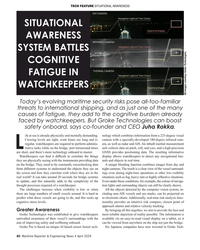 )
April 2024 - Maritime Reporter and Engineering News page: 40
)
April 2024 - Maritime Reporter and Engineering News page: 40AWARENESS SITUATIONAL AWARENESS SYSTEM BATTLES COGNITIVE FATIGUE IN WATCHKEEPERS All images courtesy Groke Technologies Today’s evolving maritime security risks pose all-too-familiar threats to international shipping, and as just one of the many causes of fatigue, they add to the cognitive
-
 )
April 2024 - Maritime Reporter and Engineering News page: 39
)
April 2024 - Maritime Reporter and Engineering News page: 39Ltd., Mitsui O.S.K. Lines, Ltd., and Bricks: 2500 pcs. enterprise owned by the Danish state, MOL Ship Management Co., Ltd. Scale: 1:25 takes his love of maritime and LEGOs The “Wall Climbing Robot” can move to high Length: 61.5 cm to new heights, creating a LEGO model With: 22.5 cm places that were previously
-
 )
April 2024 - Maritime Reporter and Engineering News page: 38
)
April 2024 - Maritime Reporter and Engineering News page: 38and the installation plan, aligning with its comprehensive "Guidelines for Shipboard CO2 Capture and Storage Systems." Image courtesy Crowley 38 Maritime Reporter & Engineering News • April 2024 MR #4 (34-44).indd 38 4/5/2024 11:08:17 A
-
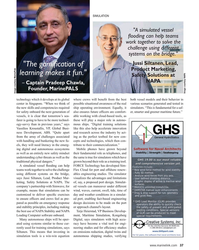 )
April 2024 - Maritime Reporter and Engineering News page: 37
)
April 2024 - Maritime Reporter and Engineering News page: 37simulators. “This is fundamental for a saf- for safety onboard the next generation of also ensures future of? cers are comfort- er, smarter and greener maritime future.” vessels, it is clear that tomorrow’s sea- able working with cloud-based tools, as farer is going to have to be more technol- these will
-
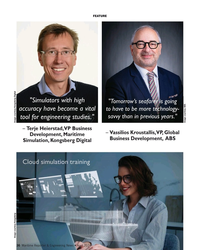 )
April 2024 - Maritime Reporter and Engineering News page: 36
)
April 2024 - Maritime Reporter and Engineering News page: 36in previous years." tool for engineering studies." Image courtesy ABS – Terje Heierstad, VP Business – Vassilios Kroustallis, VP, Global Development, Maritime Business Development, ABS Simulation, Kongsberg Digital Clou u u ud d d d d d d s si im mu ul lati io on n n n n t t training g Image courtesy
-
 )
April 2024 - Maritime Reporter and Engineering News page: 35
)
April 2024 - Maritime Reporter and Engineering News page: 35issues that hensive experience. Wärtsilä will supply its latest technology need to be addressed. One of the most important is the familiar- for a new maritime training center in Finland that will have ization of the crew with new and emerging fuels and technol- two engine room simulators along with two
-
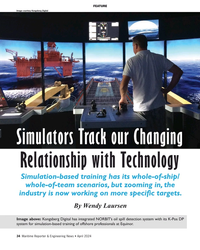 )
April 2024 - Maritime Reporter and Engineering News page: 34
)
April 2024 - Maritime Reporter and Engineering News page: 34has integrated NORBIT’s oil spill detection system with its K-Pos DP system for simulation-based training of offshore professionals at Equinor. 34 Maritime Reporter & Engineering News • April 2024 MR #4 (34-44).indd 34 4/5/2024 8:43:52 A
-
 )
April 2024 - Maritime Reporter and Engineering News page: 32
)
April 2024 - Maritime Reporter and Engineering News page: 32has a 400t main crane featur- can be stacked in multiple layers for delivery to the marshal- ing NOV’s knuckle boom design which features integrated 32 Maritime Reporter & Engineering News • April 2024 MR #4 (18-33).indd 32 4/5/2024 8:29:20 A
-
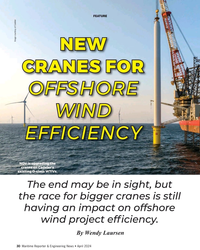 )
April 2024 - Maritime Reporter and Engineering News page: 30
)
April 2024 - Maritime Reporter and Engineering News page: 30WTIVs. The end may be in sight, but the race for bigger cranes is still having an impact on offshore wind project ef? ciency. By Wendy Laursen 30 Maritime Reporter & Engineering News • April 2024 MR #4 (18-33).indd 30 4/5/2024 8:27:59 A
-
 )
April 2024 - Maritime Reporter and Engineering News page: 28
)
April 2024 - Maritime Reporter and Engineering News page: 28the end-to-end logistics the force will require in a future major con? ict. U.S. Navy photo by Mass Communication Specialist 2nd Class John Bellino 28 Maritime Reporter & Engineering News • April 2024 MR #4 (18-33).indd 28 4/5/2024 8:27:05 A
-
 )
April 2024 - Maritime Reporter and Engineering News page: 27
)
April 2024 - Maritime Reporter and Engineering News page: 27There’s no better place that allows for upward of our rotations; and the time off compares favorably with the movement for mariners than MSC. commercial maritime industry. The Maritime Administration maintains a num- What are some of the programs you have ber of sealift ships in the Ready Reserve Fleet. initiated
-
 )
April 2024 - Maritime Reporter and Engineering News page: 26
)
April 2024 - Maritime Reporter and Engineering News page: 26USNS Burlington is the U.S. Navy’s newest expeditionary fast transport ship. U.S. Navy photo by Brian Suriani/released U.S. Navy photo by Ryan Carter 26 Maritime Reporter & Engineering News • April 2024 MR #4 (18-33).indd 26 4/5/2024 8:25:59 A
-
 )
April 2024 - Maritime Reporter and Engineering News page: 25
)
April 2024 - Maritime Reporter and Engineering News page: 25our forces ers, towing, salvage and rescue tugs, and expeditionary fast transports and emergency medical ships. A large percent- engaged in distributed maritime operations (DMO). MSC currently has 140 ships globally, including ships age of our ships are 40 years old or older and need to be that are government
-
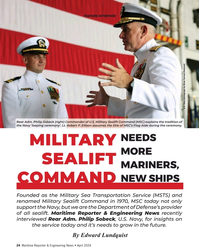 )
April 2024 - Maritime Reporter and Engineering News page: 24
)
April 2024 - Maritime Reporter and Engineering News page: 24and renamed Military Sealift Command in 1970, MSC today not only support the Navy, but we are the Department of Defense’s provider of all sealift. Maritime Reporter & Engineering News recently interviewed Rear Adm. Philip Sobeck, U.S. Navy, for insights on the service today and it’s needs to grow in
-
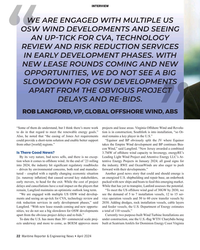 )
April 2024 - Maritime Reporter and Engineering News page: 22
)
April 2024 - Maritime Reporter and Engineering News page: 22U.S.-? ag WTIV Charybdis being ects underway and more to come, as BOEM approves more built at Seatrium Amfels for Dominion Energy Coast Virginia 22 Maritime Reporter & Engineering News • April 2024 MR #4 (18-33).indd 22 4/5/2024 8:15:09 A
